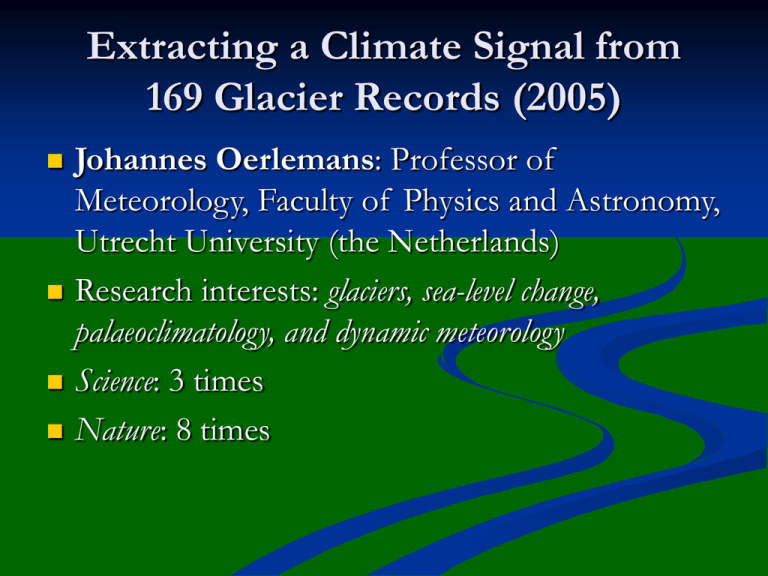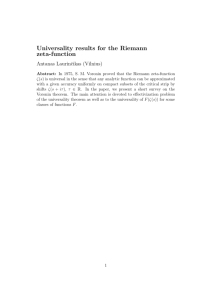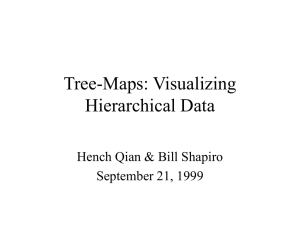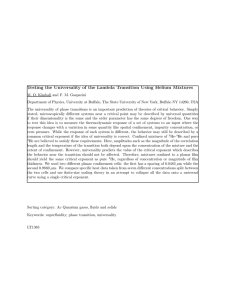Extracting a Climate Signal from 169 Glacier Records (2005)
advertisement

Extracting a Climate Signal from 169 Glacier Records (2005) Johannes Oerlemans: Professor of Meteorology, Faculty of Physics and Astronomy, Utrecht University (the Netherlands) Research interests: glaciers, sea-level change, palaeoclimatology, and dynamic meteorology Science: 3 times Nature: 8 times Supplement to Oerlemans (2005) Complexity in Natural Landform Patterns (1999) Brad Werner, Professor of Geophysics, Scripps Institution of Oceanography All degrees from California Institute of Technology Focused on complex systems, self-organization, and geophysical pattern formation Several publications in both Science and Nature on these topics The Premise Landforms are simple in their form, occupying only a small fraction of all possible forms At the same time, landforms are complex due to several interacting process components Physical Chemical Biological Natural patterns are non-linear, dependent on an infinite amount of dynamic variables A symptom of formation in an open system How Do We Model Natural Patterns? A modeling approach must provide a way to select the relevant internal dynamic variables from an infinite array of those characterizing the system Must also account for changes in the environment external to the system Reductionism and Universality are the existing modeling approaches Both inadequate for meeting the above requirements Reductionism Contends the earth is too large and complex to study as a whole Focuses on the irreducible unit Micro spatial and temporal scales Infers the behavior of a system through the sum of its parts Reductionism is inadequate due to its inability to account for the external environment Universality Presents complex systems in their simplest form Focuses on generalized principles Macro spatial and temporal scales Universality is inadequate due to its oversimplification of internal variables and the external environment, making it difficult to quantify and test models Universality Example: William Morris Davis’ model of the “Geographical Cycle” (1909) http://www.staff.amu.edu.pl/~sgp/gw/wmd/wmdfig.html Hierarchical Modeling Variables operate within a characteristic temporal scale Fast variables occur at a micro scale Slow variables occur at a macro scale Fast variables are constrained by slow variables Slow variable behavior is generated by interaction of fast variables Internal dynamic variables within a system correspond to external environmental variables Hierarchical Modeling Hierarchical Modeling Each hierarchical level is testable with respect to: Dynamic relationship with faster variable (child) Dynamic relationship with slower variable (parent) Influence from external environment Change in the external environment may affect dynamic relationships with faster and slower variables Questions Regarding Oerlemans article: Information is presented in a very dense format. Was it clear to you which results were most significant, and what were they? Is there any one aspect of the way the article was written or presented that hindered your comprehension of the subject matter? The author states that a 25% increase in precipitation is needed to compensate for mass loss due to a 1 Kelvin warming. It has been shown in other studies that global warming causes increased precipitation. Is there an equilibrium? Is there a point where the dynamics will change once a threshold has been reached? How do glacier studies help to reconstruct the past? Can they provide information about local/regional paleoenvironments? Or are they global in scale? How does glacier data contribute to local paleoecological/paleoclimatic studies? Can modeling achieve an accurate picture of the world? Is it designed to? Do we expect to? Do we place too much or too little stock in it? When is it appropriate? When is it not appropriate? What are the ways that we can reduce/remove bias from modeling? Where does Oerlemans’ recent work fit into the classification of models that Werner describes? Do you think that Oerlemans’ model is just one tier of Werner’s hierarchical model? Using glacial characteristics as an example, identify the internal dynamical variables and corresponding external environmental parameters. How do these studies fit into the sub-fields of Resource Geography and GI Science?




